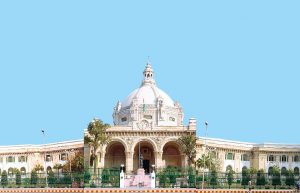Starting from Bengal in the later half of the 18th century, a series of battles for North Indian lands finally gave the British East India Company accession over this state’s territories – including the territories of Bundelkhand, Kumaon and Benaras rulers – and the last Mughal territories of Doab and Delhi. When the Company included Ajmer and Jaipur kingdoms in this northern territory, they named it the “North-Western Provinces” (of Agra). Today, the area may seem large compared to several of the Republic of India’s present ‘mini-states’ – no more than the size of earlier ‘divisions’ of the British era – but at the time it was one of the smallest British provinces. Its capital shifted twice between Agra and Allahabad.
Due to dissatisfaction with British rule, a serious rebellion erupted in various parts of North India; Meerut cantonment’s sepoy, Mangal Pandey, is widely credited as its starting point. It came to be known as the Indian Rebellion of 1857. After the revolt failed the British attempted to divide the most rebellious regions by reorganising the administrative boundaries of the region, splitting the Delhi region from ‘NWFP of Agra’ and merging it with Punjab, while the Ajmer- Marwar region was merged with Rajputana and Oudh was incorporated into the state. The new state was called the ‘North Western Provinces of Agra and Oudh’, which in 1902 was renamed as the United Provinces of Agra and Oudh. It was commonly referred to as the United Provinces or its acronym UP.
In 1920, the capital of the province was shifted from Allahabad to Lucknow. The high court continued to be at Allahabad, but a bench was established at Lucknow. Allahabad continues to be an important administrative base of today’s Uttar Pradesh and has several administrative headquarters.
Uttar Pradesh continued to be central to Indian politics and was especially important in modern Indian history as a hotbed of both the Indian Independence Movement and the Pakistan Movement. Nationally known figures such as Jawaharlal Nehru were among the leaders of the movement in UP. The All India Kisan Sabha (AIKS) was formed at the Lucknow session of the Indian National Congress on 11 April 1936 with the legendary nationalist Swami Sahajanand Saraswati elected as its first President, in order to address the long standing grievances of the peasantry and mobilise them against the zamindari landlords’ attacks on their occupancy rights, thus sparking the Farmers’ movement in India.
During the Quit India Movement of 1942, Ballia district overthrew the colonial authority and installed an independent administration under Chittu Pandey. Ballia became known then as Baghi Ballia (Rebel Ballia) for this significant contribution in India’s freedom movement.
Post-independence
Modern-day Uttar Pradesh saw the rise of important freedom fighters on the national scenario. Sri Lal Bahadur Shastri, Sri Jawaharlal Nehru, Smt. Indira Gandhi, Sri Charan Singh and Sri Chandra Shekhar were only a few of the important names who played a significant role in India’s freedom movement and also rose to become the prime ministers of this great nation.
After independence, the state was renamed Uttar Pradesh (“northern province”) by its first chief minister, Govind Ballabh Pant. Pant was well acquainted with and close to Jawaharlal Nehru (the first Prime Minister of free India) and was also popular in the Congress Party. He established such a good reputation in Lucknow that Nehru called him to Delhi, the capital and seat of Central Government of the country, to make him Home Minister of India in 27 December 1954. He was succeeded by Dr. Sampoornanand, a classicist Sanskrit scholar. Following a political crisis in Uttar Pradesh, initiated by Kamlapati Tripathi and C.B.Gupta, Sampurnanand was asked to resign as CM in 1960 and sent to Rajasthan as the Governor of Rajasthan, paving the way for Gupta and Tripathi to become Chief Ministers.
Sucheta Kripalani served as India’s first woman chief minister from October 1963 until March 1967, when a two-month long strike by state employees caused her to step down. After her, Chandra Bhanu Gupta assumed the office of Chief Minister with Laxmi Raman Acharya as Finance Minister, but the government lasted for only two years due to the confusion and chaos which ended only with the defection of Charan Singh from the Congress with a small set of legislators. He set up a party called the Jana Congress, which formed the first non-Congress government in U.P. and ruled for over a year.
Hemvati Nandan Bahuguna was chief minister for Congress Party government for part of the 1970s. He was dismissed by the Central Government headed by Indira Gandhi, along with several other non-Congress chief ministers, shortly after the imposition of the widely unpopular Emergency, when Narain Dutt Tewari – later chief minister of Uttarakhand – became chief minister. The Congress Party lost heavily in 1977 elections, following the lifting of the Emergency, but romped back to power in 1980, when Mrs. Gandhi handpicked the man who would later become her son’s principal opposition, V.P. Singh, to become Chief Minister.
Creation of the state of Uttarakhand
On 9 November 2000, the Himalayan portion of the state, comprising the Garhwal and Kumaon divisions and Haridwar district, was formed into a new state ‘Uttaranchal’, now called Uttarakhand, meaning the ‘Northern Segment’ state.
UPPCS Notes brings Prelims and Mains programs for UPPCS Prelims and UPPCS Mains Exam preparation. Various Programs initiated by UPPCS Notes are as follows:-- UPPCS Mains Tests and Notes Program
- UPPCS Prelims Exam 2024- Test Series and Notes Program
- UPPCS Prelims and Mains Tests Series and Notes Program
- UPPCS Detailed Complete Prelims Notes